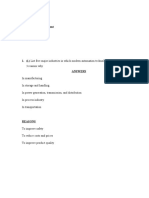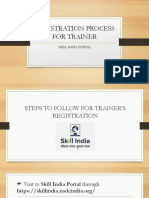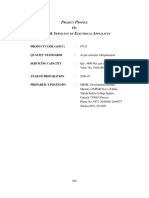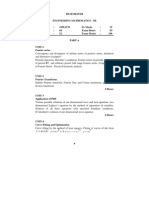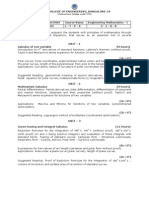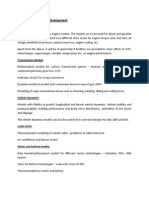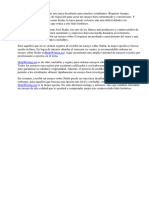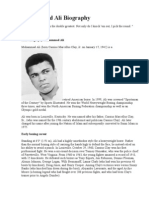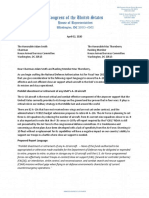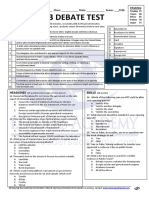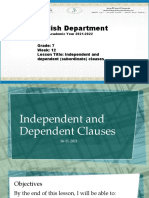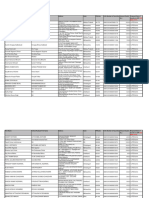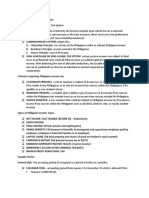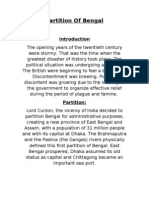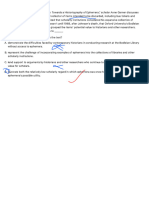Govt.
of India
Ministry of MSME
Project Profile On
LED Based Lighting systems (LED Lamps)
(i)
(ii)
Product Code
ASICC 77489
NIC 2004 31509
Quality standards:
Production Capacity:
Year of Preparation:
As per IS 16102 (Part I &II) 2012
45000 Nos. per annum
2014-2015
Prepared By
MICRO, SMALL & MEDIUM ENTERPRISES DEVELOPMENT
INSTITUTE, PATLIPUTRA INDUSTRIAL ESTATE,
PATNA-800013
�1. INTRODUCTION- LED is semiconductor Technology that emits light at the
junction of oppositely charged materials when voltage forces electron
movement. Led based lighting systems are devices consisting of many LEDs
chips embedded on the LED fixtures base and fitted with rectifier circuit that
provides regulated current output at the low voltage that makes them to be
operated on AC Circuit because LEDs requires DC to operate.
The whole PCB circuit board is fitted inside a plastic enclosure along with the
metallic cap and Smokey reflector.
2. MARKET POTENTIAL- Conventional lighting systems represent mainly
incandescent light bulbs and compact fluorescent lights (CFLs).LED lighting
system provides advantages over conventional lighting systems in terms of
better energy efficiency, better energy costs, longer lifetime, less temp.
Sensivity, higher light output. This leads them to be better Lighting substitute
and good market prospect. Therefore the market prospect for LED based
Lighting system is good and booming.
3. Basis and presumptions
(i)
The basis for calculation of production capacity has been taken on
single shift basis on 75% efficiency.
(ii)
The maximum capacity utilisation on single shift basis for 300 days
a year. During first year and second year of operations the capacity
utilisation is 60% and 80% respectively. The unit is expected to
achieve full capacity utilisation from the third year onward.
(iii) The salaries and wages, cost of raw materials, utilities, rent etc are
based on the prevailing rates in and around Patna. These cost
factors are likely to vary with time and location.
(iv)
Interest on term loan and working capital loan must be preferably
current rate. Otherwise the rate of interest on an average may be
taken as 13%. This rate may vary depending upon the policy of the
financial institution/agencies from time to time.
(v)
The cost of machinery and equipment refer to a particular
make/model and prices are approximate.
(vi)
The breakeven point percentage indicated is of full capacity
utilisation.
(vii) The project preparation cost etc whenever required could be
considered under preoperative expenses.
(viii) The essential production machinery and test equipments required
for the projects have been indicated. The unit may utilize common
test facilitates available at ETDC and ERTLs and Regional Testing
Centre (RTC).
Implementation Schedule
The major activities in the implementation of the project has been listed and the
average time for implementation of the project is estimated at 12 months:
Name of activity
Period in months (suggestive)
1.Preparation of Project Report
1
2.Registration and other formalities
1
�3.Sanction of loan by financial institution
3
4. Plant and machinery
(a) Placement of order
1
(b) Procurement
2
(c) Installation /erection of machinery/test equipments
2
5.Procurement of raw material
2
6.Recruitment of technical person etc
2
7. Trial production
11th month
8.commercial production
12th month
Note
1. Many of the above activities shall be initiated concurrently.
2. Procurement of raw materials commences from 8th month onwards.
3. When imported plant and machinery are required the implementation period of
projects may vary from 12 months to 15 months.
Technical aspect
Process of Manufacturing; This project profile is made for the assembling of LED
based Lighting system cum LED Lamp up to 10 W. The assembling of LED based
Lighting system cum LED Lamp consists of the following steps:
1. Procurement/import of LED chips of Mili Watt rating, Procurement of Circuit
and other mounting devices.
2. Embedding of LED Chips of miliwatt rating on the PCB board with the
rectifier circuit, filter circuit etc.
3. Fitting of PCB Board with the holder cap and plastic modules fitted with the
Smokey reflector to form a compact unit.
4. Testing of the assembled LED Lighting systems and packing
Quality controls & Standards
As Per IS 16102 (Part I & II) 2012
Production Capacity (Per annum)
Qty; 45000Nos.
Value: Rs.6750000
4.
Motive power
5kw
5. Pollution control
The govt. Accords utmost importance to control environmental pollution. The
Small- Scale entrepreneur should have an environmental friendly attitude and
adopt pollution control measures by process modification and technology
substitutions.
India having acceded to the Montreal Protocol in sept.1992,the production and use
of Ozone depleting substances (ODS) like Chlorofluore Carbon (CFCs), carbon
tetrachloride, halons and methyl Chloroform etc. Need to be phased out
immediately with alternative chemicals/solvents. A notification for detailed rules
to regulate ODS phase out under the Environment Protection Act 1986 have been
put in place with effect from 19th July 2000.
The following steps are suggested which may help to control pollution in
electronics industry wherever applicable:
�i) In electronic industry fumes and gases are released during hand
soldering/wave soldering/dip soldering, which are harmful to people as
well as environmental and the end products. Alternative technologies may
be used to phase-out the existing polluting technologies. Numerous new
fluxes have been developed containing 2-10% solids as apposed to the
traditional 15-35 % solids.
ii) Electronic industry uses CFCs,carbon tetrachloride and Methyl chloroform for
cleaning of printed Circiut boards after assembly to remove flux residues
left after soldering and various kinds of foams for packaging.
Many alternative solvents could replace CFC-113 and methyl chloroform in
electronics cleaning. Other chlorinated convents such as trichloroethylene,per
chloroethylene and methylene chloride have been used an effective cleaners in
electronic industry for many years. Other organic solvents such as Ketenes and
Alcolols are effective in removing both solder fluxes and many polar
contaminants.
6.Energy conservation
With the growing energy needs and shortage coupled with rising energy cost, a
greater thrust in energy efficiency in industrial sector has been given by Govt. of
India since 1980s. The energy Conservation Act 2001 has been enacted on 18th
August 2001which provides for efficient use of energy its conservation and
capacity building of Bureau of Energy Efficiency created under the act.
The following steps may be help for conservation of Electrical Energy:
i)
Adoption of energy conserving technology, production aids and testing
facilities.
ii)
Efficient management of process/manufacturing machineries and systems,
QC and testing equipments for yielding maximum energy conservation.
iii)
Optimum use of electrical energy for heating during soldering process can
be obtained by using efficient temperature controlled soldering and
desoldering stations.
iv)
Periodical maintenance of motors compressors etc
v)
Use of power factor correction capacitors, proper selection and layout of
lighting systems timely switching on/off of the lights, use of Compact
Fluorescent Lamps wherever possible.
FINANCIAL ASPECT
(I) Land and building
Built up Area
Office, Store
Assembly and Testing
Rent payable Per Annum
3000 SqFt
1000 Sq Ft
2000 Sq Ft
6000
(ii) Machinery and equipment
Sn
1
Description
Component forming
Ind/imp
Indian
Qty
02
Value (RS.)
1,00000
�machine
2
Soldering Machine
Indian
10
5,000
Digital Multimeter
Indian
02
8,000
Continuity Tester
Indian
10
1000
Sealing Machine
Indian
01
10,000
Packaging Machine
Indian
01
15,000
7
8
9
10
11
LCR Meter
Small Drilling M/C Set
Lux Meter
Oscilloscope
Personnel Computer
with UPS and Printer
Miscellaneous items
Indian
Indian
Indian
Indian
Indian
02
01
01
01
01
20,000
10,000
40,000
60,000
80,000
10,000
Total = 359000
Other Fixed Assets in (RS.)
Electrification
charges@10%of cost
of machinery and
equipment
Office equipment,
furniture and working
table etc
Tools, jigs and fixtures
Pre operative expenses
Misc.
Total
35900
20,000
20,000
5,000
5,000
85900
Total Fixed Capital = 444900
Working Capital Per Month
i)
Staff & Labour
SN
Description
No of
Persons
Salary/month
(RS.)
Supervisor Cum Manager
01
8,000
Skilled Worker
05
4,000
Total Salary
per month
(RS.)
8,000
20,000
Accountant
01
6,000
6,000
Total = 34,000
ii)
Raw Material Requirement Per Month
SN
1
Description
LED Chips
Qty
Rate
Value (Rs.)
180000
45000
Rectifier Circuit with
filter
3750
20
75000
Heat Sink Devices
3750
18750
Metallic Cap Holder
3750
10
37500
Plastic Body
3750
10
37500
Reflector Plastic Glass
3750
10
37500
Connecting wire
Lumsum
5,000
Soldering Flux
Lumsum
5,000
10
Miscellaneous
10,000
11
Packaging Material
10,000
Total= 416250
iii)
Utilities Per Month
Value in (RS.)
Power
Water
3,000
500
Total=3500
Other Contingent Expenditure Per Month
SN
1
2
3
4
5
6
7
8
Item
Rent
Postage and stationary
Telephone/fax
Repair & Maintenance
Transport and Conveyance charges
Adv. And publicity
Insurance and Taxes
Miscellaneous expenditure
Amount (RS.)
6000
500
2000
1000
1500
1000
1000
1000
Total= 14000
�Total Reoccurring Expenditure Per Month (I+ii+iii+iv)= 467750
Total Capital Investment (In RS.)
Fixed capital
Working capital for three month
444900
1403250
Total= 1848150
Financial analysis
Cost of production per annum
Total reoccurring expenditure
Depreciation on machinery and
equipment@10%
Depreciation on tools, jigs and
fixtures @25%
Depreciation on office equipments,
furniture @ 20%
Interest on total Capital investment
@ 13%
5613000
35900
5000
4000
240259
Total= 5898159
Turn over per annum
Item
Qty (Nos)
Rate/unit
LED Lamp
45000
150
Total value (Rs.)
6750000
Profit per annum (before Taxes)= Turn over per annum- Cost of Production
per annum = 851841
Net profit ratio= profit/annum*100/sales/annum = 13%
Rate of Return = Profit/annum*100/ Total Capital Investment = 46%
Break-even Point
Fixed cost per annum
Rent
Depreciation on machinery and
equipment @ 10%
72000
35900
�Depreciation on tools, jigs and
fixtures @ 25%
Depreciation on office equipment,
furniture @ 20%
Interest on total capital
investment@13%
Insurance
40% of salaries and wages
40% of other contingents & utilities
(excluding rent & insurance)
Total fixed cost
5000
4000
240259
1000
163200
33600
554959
Break even point = fixed cost *100/ fixed cost +Profit
= 554959X100/1406800=39%
Additional information
The Project Profile may be modified/tailored to suit the individual
entrepreneurship qualities/capacity, production programme and also
suit the location characteristics, wherever applicable.
The margin money recommended is 25 % of the working capital
requirement at an average. However, the percentage of margin money
may vary as per banks discretion
Name & address of Machinery and equipment supplier
1. Kamal Electronics, 14, Lakshmi Building, J.C.Road,Bangalore-560002
2. Static systems Pvt. Ltd.,925,II Floor,3rd Main,3rd Cross,D block,2nd
Stage,Rajajinagar,Bangalore-560010
3. Buljin ELMEC Pvt. Ltd.,2/10,Plot No. 65 &78,Krishna Industrial
estate,Mettukuppam,Vanagaram,Chennai-600095
Name & address of raw Material Suppliers
1. M/S Micrologix,473/D,13th Cross,4th Phase,Peenya industrial Area,
Bangalore 560058
2.B.M.V. Circuit Systems,C/321, sector 10,Noida-201301
3.M/S Signal Circuits,7,Navjeevan,Rajguru Nagar,Pune-410505












































